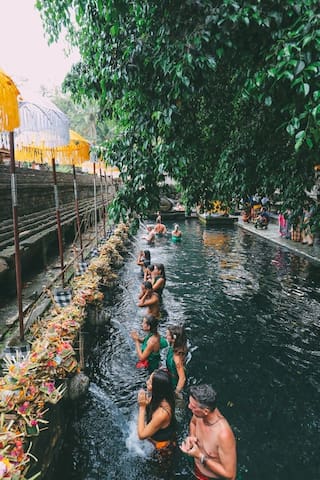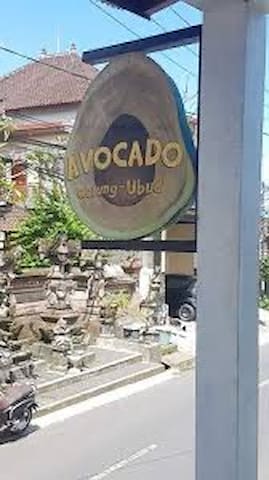Tempat Jalan-jalan
Mandala Suci Wenara Wana, or well known as Ubud Monkey Forest, is the sanctuary and natural habitat of the Balinese long-tailed macaque. It is located at Padangtegal Ubud, Bali. About 1049 monkeys live in this sanctuary.
Sacred Monkey Forest Ubud is a famous tourist attraction in Ubud. In every month around 10,000–15,000 visitors come to Monkey Forest Ubud. The Monkey Forest Ubud has 186 species of plants and trees in 12,5 hectares of forest. The Monkey Forest Ubud has 3 temples, namely Dalem Agung Padangtegal Temple, Holy Spring Temple and Prajapati Temple.
The Monkey Forest grounds have a forest conservation area, a public hall and gallery, an open stage, a canteen, a first aid center, a police post, parking and toilet facilities, and a composting facility.
The Monkey Forest grounds are home to three Hindu temples, all apparently constructed around 1350
The Pura Dalem Agung Padangtegal ("Padangtegal Great Temple of Death"), also known as the Main Temple, lies in the southwestern part of the park. The temple is used for worshiping the god Hyang Widhi in personification of Shiva, the Recycler or Transformer.
The Pura Beji, or Beji Temple, in the northwestern part of the park, is used for the worship of Hyang Widhi in personification of the goddess Gangga. A "Holy Spring" bathing temple, it is a place of spiritual and physical cleansing and purification prior to religious ceremonies.
The Pura Prajapati, or Prajapati Temple, located in the northeastern part of the park, is used to worship Hyang Widhi in personification of Prajapati. A cemetery adjacent to this temple receives the bodies of the deceased for temporary burial while they await a mass cremation ceremony, held once every five years.
The temples play an important role in the spiritual life of the local community, and the monkey and its mythology are important in the Balinese art tradition. The Monkey Forest area is sanctified by the local community, and some parts of it are not open to view by the public. Sacred areas of the temples are closed to everyone except those willing to pray and wear proper Balinese praying attire.
774 recommandé par les habitants
Forêt des singes d'Ubud
Jalan Monkey ForestMandala Suci Wenara Wana, or well known as Ubud Monkey Forest, is the sanctuary and natural habitat of the Balinese long-tailed macaque. It is located at Padangtegal Ubud, Bali. About 1049 monkeys live in this sanctuary.
Sacred Monkey Forest Ubud is a famous tourist attraction in Ubud. In every month around 10,000–15,000 visitors come to Monkey Forest Ubud. The Monkey Forest Ubud has 186 species of plants and trees in 12,5 hectares of forest. The Monkey Forest Ubud has 3 temples, namely Dalem Agung Padangtegal Temple, Holy Spring Temple and Prajapati Temple.
The Monkey Forest grounds have a forest conservation area, a public hall and gallery, an open stage, a canteen, a first aid center, a police post, parking and toilet facilities, and a composting facility.
The Monkey Forest grounds are home to three Hindu temples, all apparently constructed around 1350
The Pura Dalem Agung Padangtegal ("Padangtegal Great Temple of Death"), also known as the Main Temple, lies in the southwestern part of the park. The temple is used for worshiping the god Hyang Widhi in personification of Shiva, the Recycler or Transformer.
The Pura Beji, or Beji Temple, in the northwestern part of the park, is used for the worship of Hyang Widhi in personification of the goddess Gangga. A "Holy Spring" bathing temple, it is a place of spiritual and physical cleansing and purification prior to religious ceremonies.
The Pura Prajapati, or Prajapati Temple, located in the northeastern part of the park, is used to worship Hyang Widhi in personification of Prajapati. A cemetery adjacent to this temple receives the bodies of the deceased for temporary burial while they await a mass cremation ceremony, held once every five years.
The temples play an important role in the spiritual life of the local community, and the monkey and its mythology are important in the Balinese art tradition. The Monkey Forest area is sanctified by the local community, and some parts of it are not open to view by the public. Sacred areas of the temples are closed to everyone except those willing to pray and wear proper Balinese praying attire.
The Campuhan Ridge walk is definitely at the top of the list of must do walks when in Ubud. It is a beautiful walk which is filled with greenery and hills. It’s more of a jungle or forest walk so if you wanted to only see rice fields and terraces there are other walks you can do.
The things you can see when you walk around Campuhan is : Campuhan Rivers, Gunung Lebah Tample, Campuhan Bridge
318 recommandé par les habitants
Campuhan Ridge Walk
Jalan Raya CampuhanThe Campuhan Ridge walk is definitely at the top of the list of must do walks when in Ubud. It is a beautiful walk which is filled with greenery and hills. It’s more of a jungle or forest walk so if you wanted to only see rice fields and terraces there are other walks you can do.
The things you can see when you walk around Campuhan is : Campuhan Rivers, Gunung Lebah Tample, Campuhan Bridge
Purification
Tirta Empul is a temple considered sacred by Balinese Hindu community. The temple has several holy springs which are said to have been created by The God Indra and believed to be blessed water that could purify those who bathe there.
Tirta Empul is dedicated to Vishnu, the Hindu God of water. In the Balinese language, Tirta Empul loosely translated means water gushing from the earth, which for this reason Tirta Empul is regarded as a holy spring. The Tirta Empul Temple includes shrines to Shiva, Vishnu, Brahma, as well as one for Indra and Mount Batur. It is considered one of the five most holy temples in all of Bali and is considered one of the holiest water sources in Bali.
The Tirta Empul Holy Water Temple is located in the village of Manukaya, near the town of Tampaksiring, not far from Ubud, in the Gianyar Regency
As a petirtaan or bathing center, Tirta Empul is quite a large temple complex and it takes at least 30 minutes to an hour to explore the entire site. Just as at other temples and sacred sites around the island, you will need to put on a 'sarong' before entering the premises. The sarongs are available at the temple's entrance and can be rented for a small donation.
The holy springs here bubble up into a large, crystal-clear pool within the temple and gush out through 30 waterspouts into the two sacred purification pools. Local Balinese and Hindu worshippers stand in long lines in the pools waiting to dip their heads under the waterspouts in a purification ritual known as melukat. Bathers start in the pool on the left side standing in the pool to the waist under the first water spout. Once they have cleansed themselves under the first spout they join the next queue. This process is continued until they have cleansed themselves under each waterspout. However, there are two spouts that are meant only for cleansing the dead and are prohibited to be used by the living for the melukat ritual.
Tirta empul healing Holy temple
Tirta Empul is a temple considered sacred by Balinese Hindu community. The temple has several holy springs which are said to have been created by The God Indra and believed to be blessed water that could purify those who bathe there.
Tirta Empul is dedicated to Vishnu, the Hindu God of water. In the Balinese language, Tirta Empul loosely translated means water gushing from the earth, which for this reason Tirta Empul is regarded as a holy spring. The Tirta Empul Temple includes shrines to Shiva, Vishnu, Brahma, as well as one for Indra and Mount Batur. It is considered one of the five most holy temples in all of Bali and is considered one of the holiest water sources in Bali.
The Tirta Empul Holy Water Temple is located in the village of Manukaya, near the town of Tampaksiring, not far from Ubud, in the Gianyar Regency
As a petirtaan or bathing center, Tirta Empul is quite a large temple complex and it takes at least 30 minutes to an hour to explore the entire site. Just as at other temples and sacred sites around the island, you will need to put on a 'sarong' before entering the premises. The sarongs are available at the temple's entrance and can be rented for a small donation.
The holy springs here bubble up into a large, crystal-clear pool within the temple and gush out through 30 waterspouts into the two sacred purification pools. Local Balinese and Hindu worshippers stand in long lines in the pools waiting to dip their heads under the waterspouts in a purification ritual known as melukat. Bathers start in the pool on the left side standing in the pool to the waist under the first water spout. Once they have cleansed themselves under the first spout they join the next queue. This process is continued until they have cleansed themselves under each waterspout. However, there are two spouts that are meant only for cleansing the dead and are prohibited to be used by the living for the melukat ritual.
Ajang kuliner
Good to try the foods here. They also provide Balinese food like Ayam betutu
13 recommandé par les habitants
Made Becik Waroeng
6 Jl. Tirta TawarGood to try the foods here. They also provide Balinese food like Ayam betutu
The grill ubud
Jalan Tirta TawarAll food made by avocado is available here. This is the highest rating warung around Ubud especially near with my villa. It’s only 2 minutes to get here.
17 recommandé par les habitants
Warung Mina Ubud
2 Banjar AmbenganAll food made by avocado is available here. This is the highest rating warung around Ubud especially near with my villa. It’s only 2 minutes to get here.


